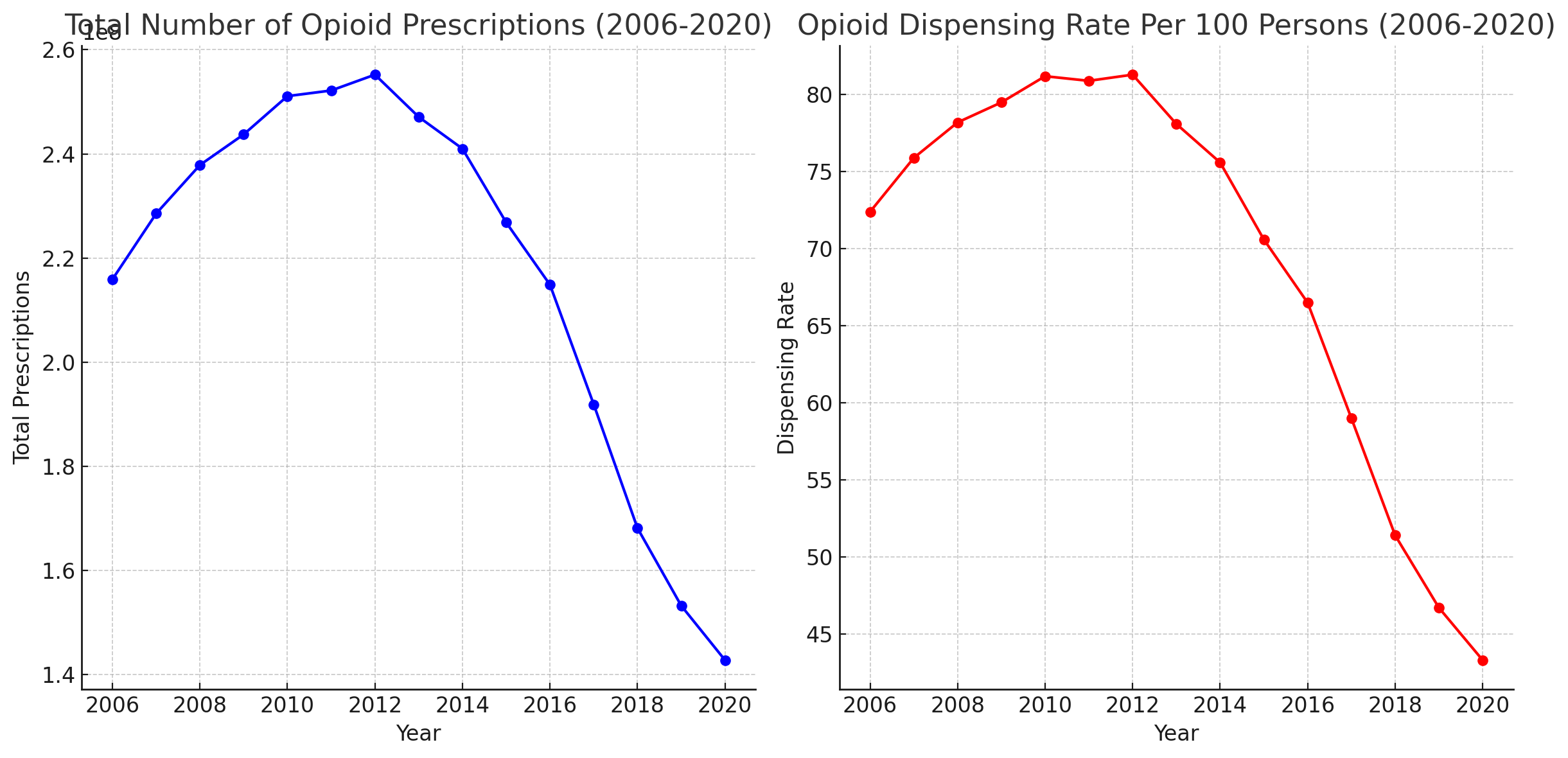Prescription opioids are medications that doctors prescribe to treat moderate to severe pain. They work by binding to opioid receptors in the brain and spinal cord, reducing the perception of pain. These drugs are legal when prescribed by a healthcare professional, but they carry a risk of addiction and dependence due to their powerful pain-relieving and euphoric effects.
1 in 4 Patients
According to the Centers for Disease Control and Prevention, approximately one in four patients receiving long-term opioid therapy in a primary care setting struggles with opioid addiction. This highlights a significant challenge in managing long-term opioid therapy and underscores the need for careful monitoring and support for individuals receiving these medications.
Most frequently prescribed opioids
Opioid Prescriptions by Year
The table below shows a year-by-year account of the number of opioid prescriptions as well as the dispensing rate per 100 people. After a steady increase in the overall national opioid dispensing rate starting in 2006, the total number of prescriptions dispensed peaked in 2012 at more than 255 million and a dispensing rate of 81.3 prescriptions per 100 persons.
| Year | Number Of Opioid Prescriptions | Dispensing Rate Per 100 Persons |
|---|---|---|
| 2006 | 215,917,663 | 72.4 |
| 2007 | 228,543,773 | 75.9 |
| 2008 | 237,860,213 | 78.2 |
| 2009 | 243,738,090 | 79.5 |
| 2010 | 251,088,904 | 81.2 |
| 2011 | 252,167,963 | 80.9 |
| 2012 | 255,207,954 | 81.3 |
| 2013 | 247,090,443 | 78.1 |
| 2014 | 240,993,021 | 75.6 |
| 2015 | 226,819,924 | 70.6 |
| 2016 | 214,881,622 | 66.5 |
| 2017 | 191,909,384 | 59.0 |
| 2018 | 168,158,611 | 51.4 |
| 2019 | 153,260,450 | 46.7 |
| 2020 | 142,816,781 | 43.3 |
Analysis
The overall national opioid dispensing rate declined from 2012 to 2020, and in 2020, the dispensing rate had fallen to the lowest in the 15 years, for which we have data at 43.3 prescriptions per 100 persons (total of more than 142 million opioid prescriptions).
Graphs

Overdoses
Opioid prescribing by physicians and other health professionals has decreased for the 13th consecutive year, down nearly 50% since 2012. However, overdoses and deaths related to illicitly manufactured substances like fentanyl and xylazine continue to increase. In 2022, more than 107,000 people died from drug-related overdoses in the United States, with the epidemic increasingly impacting young people, Black and Brown people, and pregnant individuals. The dispensing of naloxone, a medication used to reverse opioid overdoses, has increased more than 200% since 2018, and buprenorphine, used for treating opioid use disorder, has nearly doubled in community pharmacies in the past 10 years.
From 1999 to 2021, nearly 280,000 people in the United States died from overdoses involving prescription opioids. In 2021, 45 people died each day from a prescription opioid overdose, totaling nearly 17,000 deaths. Prescription opioids were involved in nearly 21% of all opioid overdose deaths in 2021.
Graph- 1999 – 2018 Opioid Overdose Deaths per year

Statistics
Despite a decrease in the rate of opioid prescriptions, the number of prescription overdoses has not declined proportionally. Up to 92% of opioid abusers use prescription opioids at least once a year. Prescription opioid abuse incurs an annual cost of $78.5 billion, including healthcare, legal programs, and lost productivity.
Dangers of Combining Opioids and Benzodiazepines
Combining opioids with benzodiazepines presents significant health risks due to their synergistic effects on the central nervous system. Both opioids and benzodiazepines are central nervous system depressants, meaning they slow down brain activity. When taken together, their combined effect can dangerously enhance this slowing, leading to severe respiratory depression. This is one of the most critical risks, as it can result in decreased oxygen to the brain, potentially causing coma or fatal respiratory failure. The risk is particularly acute for individuals with underlying respiratory conditions, such as asthma or chronic obstructive pulmonary disease (COPD). Moreover, this combination significantly impairs cognitive and motor functions, increasing the risk of accidents, falls, especially in the elderly, and impaired ability to perform tasks that require alertness, such as driving.
Dependency
Those who use prescription opioids are at risk of dependency and addiction. According to a Pubmed study, the lifetime prevalence of any prescription opioid-use disorder in this cohort was 41.3%, with 28.1% for mild symptoms, 9.7% for moderate symptoms, and 3.5% for severe symptoms. It’s important to note that this study focused on opioid use disorder, which encompasses both dependence and addiction as per the DSM-5 criteria, rather than solely on physical dependence.
The research suggests that the prevalence of opioid use disorder, which includes dependence, among long-term opioid users is significantly high.
Possible Side Effects
Taking prescription opioids can lead to some serious side effects, including:
Other resources
Help For Families with an Opioid Problem.
The Coffee Connection – Understanding and Relating to Addiction.
Addiction Gap is a certified 501(c)(3) nonprofit
